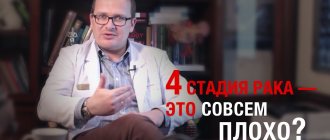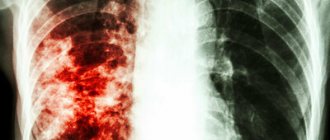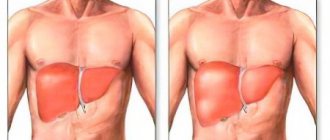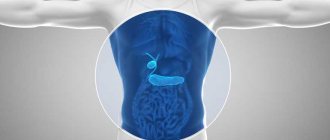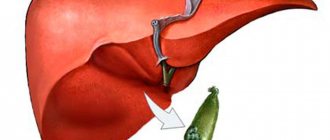What are the reasons?
Among the infections that can cause mesadenitis in a child are bacteria such as:
- coli;
- staphylococci;
- streptococci;
- salmonella;
- Mycobacterium tuberculosis.
These may also be the following viruses:
- enterovirus;
- adenovirus;
- Epstein-Barr virus;
- cytomegalovirus.
Doctors often associate the development of mesadenitis in children with the presence of diseases such as:
- pneumonia;
- flu;
- Infectious mononucleosis;
- tonsillitis;
- bronchitis.
After severe infectious diseases, a child is often diagnosed with reactive mesadenitis. In addition, this pathology often occurs in children as a specific reaction to vaccinations or uncontrolled use of certain types of medications.
Republican Children's Clinical Hospital
What is lymphadenopathy in a child? This is an enlargement of lymph nodes in one or more areas of the body due to a disease. What are they needed for? Lymph nodes are “customs” for a large area of the human body. Although these are small round formations the size of beans or peas, they are nevertheless intended to be the first barrier to pathogens of infectious diseases: bacteria, viruses, fungi, protozoa, preventing the spread of infection deep into the body. Therefore, lymph nodes are located singly or in groups, but always in strategically important places.
Lymphadenopathy is a symptom of the disease. Which one exactly? The doctor will answer this question. Unfortunately, this important symptom is not always assessed adequately and in a timely manner. Parents should know that if one or more enlarged lymph nodes are detected in one group, the child should be consulted with a pediatrician. In most cases, the cause of enlarged lymph nodes is infectious processes (viral, bacterial, fungal, protozoal), less often - autoimmune diseases, storage diseases. However, such causes can also be malignant neoplasms.
Among infectious causes, enlargement of lymph nodes is most often caused by staphylococcal or streptococcal infections - tonsillitis, pharyngitis, scarlet fever, complicated caries, boils, diseases of the upper respiratory tract, and less often - diphtheria, tuberculosis, plague. In this case, complaints, a thorough examination, medical history, analysis of Mantoux reactions and the vaccination calendar will help determine and prescribe treatment. Often the cause is “cat scratch” disease, when a child, a few days or even 2-3 weeks after a child has been scratched on the arms or legs by a tormented cat, the lymph nodes of the axillary or groin areas, respectively, enlarge and become painful. In this case, the doctor will prescribe adequate antibacterial therapy.
Among viral infections, one should think about rubella, chickenpox, mumps, cytomegalovirus, infectious mononucleosis, and HIV infection. To diagnose these conditions, an increase in body temperature, a rash on the skin and mucous membranes, pain when opening the mouth, puffiness of the face, snoring at night, purulent sore throat, and the presence of contacts with patients the day before will be important.
However, with this variety of causes, a doctor who is alert to cancer will identify a group of patients with suspected malignant tumor or blood disease and refer the child to an oncohematologist for consultation.
When treating cancer, early diagnosis is the most important step on the path to recovery. Treatment of a patient at the first stage is the most promising and cheapest. Unfortunately, many people are convinced that malignant tumors practically never occur in children. However, it is not. Being, fortunately, a fairly rare disease, malignant tumors rank second after injuries among the causes of death in children under 15 years of age. As data from statistical studies show, every year out of 100 thousand children of this age, 14-15 are diagnosed with malignant neoplasms.
Symptoms that should alert a child with lymphadenopathy include significant weight loss in a short time, persistent loss of appetite, bone pain, increased fatigue (the child gets tired faster than usual, forgetting even about his most favorite games), lethargy, pale skin, bruises on the body without obvious injuries, hemorrhages in the mucous membranes, unexplained rises in body temperature.
But despite the presence or absence of these symptoms in the child, parents should understand that until the reasons are determined, they should not warm the lymph nodes, carry out any physical procedures (electrophoresis, applications, etc.), or lubricate them with anything. Any physical procedures on the area of the lymph nodes are contraindicated, as they can aggravate the process, causing rapid progression and thus reducing the chances of recovery with even more expensive treatment. There are cases when such errors became fatal.
Thus, the attentiveness and prudence of parents plays a huge role in timely diagnosis and initiation of treatment. Who, if not parents, will be able to notice changes in their child’s condition in time - and contact specialists in time, without making mistakes along the way? As American oncologist Charles Cameron wrote: “Be neither too careless about the possibility of cancer in children nor too worried. But be on your guard!”
| Pediatric hematologist, KRU "DKB" | Tarasenkova A.A. |
Answer
Symptoms of the disease
The main symptom of the disease is pain in the abdomen (in the upper part or in the navel area). The pain can be paroxysmal and last a long time, it can be dull and not particularly pronounced. Painful sensations become more pronounced with sudden turns of the body, lifting weights, sneezing, coughing. Often there is a feeling of nausea, there may be vomiting, and intestinal disorders.
The presence of an inflammatory process in the body causes signs of intoxication: an increase in the number of heart contractions (tachycardia) and general weakness; body temperature in acute mesadenitis can rise to 390C. In chronic cases, it is usually not high, it can rise to 37 or 37.5 and lasts a long time. With chronic mesadenitis, pain lasts for weeks or months, the child becomes lethargic, tired, and performance and mental activity decrease.
I reviewed popular science articles on the Internet and did not find them useful for parents (in my opinion). It's just creepy! If I were not a doctor and such a conclusion was written for my precious child, I would have fainted. But let me quote the expression of Professor N.V. Zabolotskaya. “... when we see lymph nodes, it means we are alive!”
What is a lymph node? This is our protector, bodyguard, face control, one might say. Anything foreign must pass through them, be identified and, if it poses a danger, protective measures must be taken in the node. Now we have a long-awaited baby, from the cozy mother’s tummy he has entered a world where he is surrounded by millions of microorganisms, viruses, allergens and other irritants. Who will help him with this? Lymph nodes in the abdomen are one of the first to be on guard! The lymph nodes of the small intestine were discovered as early as 1922. Nowadays, all mothers know about immunity and try to “increase” it, but for some reason, when it comes to lymph nodes, representatives of the immune system , panic arises. Nature has thought of everything! After all, most unfavorable agents and simply unfamiliar substances (foods, drinks, medications, etc.) pass through the digestive system, and even what passes through the child’s nose partially ends up there. Plus, lymph nodes help all organs fight their problems (be it gastritis, flu or vaccination). Here's your answer - the lymph nodes in children's stomachs are of enormous importance, they are constantly at work ( this is called activation). If suddenly some “evil enemy” comes across, then this activation can be significantly pronounced and the child begins to be bothered by abdominal pain. The knot grows, it can be compared to a muscle - the one with the most “pumped” muscle will win, so the knot becomes larger in order to give a strong fight back.
From my own experience, I can say that there are no children in whom I would not see lymph nodes in the abdomen. Their number can reach 170-200. The amount decreases with age. That's why we see them less often in older schoolchildren. The size of a normal lymph node is a relative concept , so as not to delve into medical knowledge, I will only say that the size of the node is not as important as its structure. The doctor must be able to distinguish “good, protective” activation of lymph nodes from “bad” (against the background of tumor processes). In the vast majority of cases, in practice we have precisely reactive lymphadenopathy of the mesenteric lymph nodes (in our region they simply write “mesadenitis” or “enlarged abdominal lymph nodes”). The very definition of “reactive” tells us that this is a defensive reaction to some problem in the body.
Is it worth seeing a doctor then?
Necessarily!
In any case, you need to contact your pediatrician. Control ultrasound examinations must be carried out by a doctor who has extensive experience in this area and can competently explain everything and not scare parents. Modern equipment makes it possible to fairly clearly assess the structure of the nodes, but if the doctor rarely encounters them in practice or is not familiar with the work of the lymphatic system in children, then he can mislead you. Every year I conduct about 3 thousand or more thousand examinations of the abdominal organs, intestines and intra-abdominal lymph nodes, most of them are in children, and I always examine the lymph nodes (regardless of the reason for the examination).
And one moment. You should not expect that the size of the lymph nodes will radically decrease during dynamic observation. The node can remain active for a long time, because the child “hardens” his lymphatic system every day.
Here is the lymph node - our little protector!
I hope that this information helped you.
Health to your kids!
Cervical lymphadenitis - symptoms and treatment
Elimination of the primary source of infection
Cervical lymphadenitis is often caused by acute or aggravated periodontitis and complications of advanced caries, such as acute purulent periostitis.
If the tooth can be saved, the root canals are cleaned and filled. If it is impossible to restore a tooth, it is removed. When a purulent focus has formed, the diseased tooth is treated or removed, and the abscess is opened. If cervical lymphadenitis has developed due to a disease of the ENT organs, the source of acute inflammation should also be eliminated.
Drug therapy
- Antibacterial therapy. Broad-spectrum antibiotics are usually used, mainly with a bactericidal effect. The components of such drugs destroy the cell wall of the bacterium or disrupt its metabolic processes, which leads to the death of the microbe. If the patient's condition does not improve, biological material obtained from the lymph node is examined and the sensitivity of microorganisms to drugs is determined.
- Antiviral drugs are used for viral origin of lymphadenitis, for example, herpes.
- Anti-inflammatory drugs suppress inflammation at the cellular level, reduce pain and reduce fever.
- Antihistamines reduce capillary permeability, which prevents the development of edema and congestive processes. They also prevent leukocytes from penetrating into the lesion and inhibit the production of substances that contribute to the development of inflammation.
Physiotherapeutic treatment
- UHF (ultra-high frequency therapy) is aimed at reducing swelling, inflammation and pain.
- Ultrasound is used to speed up the resolution of the inflammatory process.
- UVR (ultraviolet irradiation) is indicated to reduce inflammation.
- Laser therapy is aimed at reducing pain, improving nutrition and blood supply to the affected area.
- Electrophoresis is a method in which a medicinal substance penetrates tissue using a direct electric current. For lymphadenitis, electrophoresis with potassium iodide and proteolytic enzymes is usually performed.
- Magnetic therapy is aimed at reducing pain, inflammation, swelling and congestion in tissues.
Physiotherapeutic methods are used in Russia to reduce the duration of drug treatment, but there is insufficient scientific evidence of their effectiveness.
Surgical intervention
Opening a purulent focus is indicated for purulent forms of lymphadenitis and adenophlegmon. Depending on the size of the lesion, the operation is performed under local or general anesthesia. During surgery, the purulent contents and tissue of the disintegrated lymph node are removed.
After surgical treatment, a drainage is placed in the wound, which ensures the drainage of pus and prevents the edges of the wound from healing. Then the wound is treated, its edges are renewed and sutured.
Detoxification therapy
Reduces the level of toxins in the body by diluting them, absorbing breakdown products and increasing diuresis. To do this, drink more fluid, and in severe cases, Hemodez and Reogluman are administered intravenously.
Diet
It is recommended to eat a balanced diet and consume enough vitamins, macro- and microelements.
Features of treatment of lymphadenitis
Treatment of cervical lymphadenitis directly depends on the stage and form of the disease.
In acute serous lymphadenitis, special attention is paid to the primary source of inflammation: inflammatory diseases of the teeth, oral cavity and ENT organs. If the primary inflammatory process is stopped in the early stages, then the symptoms of acute serous lymphadenitis also become less pronounced.
In almost 98% of cases with acute lymphadenitis, it is possible to identify the primary lesion [10]. It is eliminated and antibacterial, antiviral, anti-inflammatory or antihistamine therapy is prescribed.
When a purulent form develops, the primary focus is eliminated, the abscess is opened and the tissue of the disintegrated lymph node is removed. The patient is usually kept in the hospital under 24-hour observation. Daily dressings are performed, antibacterial, anti-inflammatory, antihistamine and detoxification therapy is prescribed.
In case of chronic hyperplastic lymphadenitis, the affected lymph node is removed, and treatment is also carried out in the hospital. Tissue fragments are sent to the laboratory, processed and examined under a microscope. This procedure allows you to exclude cancer and prevent its development.
Causes of enlarged lymph nodes in a child
If your doctor suspects that your lymphadenopathy is not the result of an infection, the first step is to perform a physical examination and take a detailed medical history. Hard, dense nodes that do not move under the fingers will be the basis for referring the child for laboratory tests, possibly also for imaging. Only if the test results are concerning, the doctor will order a histopathological examination.
Basically, there can be two reasons for enlarged lymph nodes in a child. The first is the proliferation of nodal cells, mainly lymphocytes. The second reason is infiltration caused by foreign cells - inflammatory and malignant. Neoplastic diseases that present with lymphadenopathy include lymphocytic lymphoma and Hodgkin lymphoma. However, cancer is not the main cause of enlarged lymph nodes. More often, lymphadenopathy is caused by: - viral infections;
- allergies; — vaccination; - autoimmune diseases.
What are lymph nodes?
Lymph nodes are structures of the immune system that act as a specific filter for microbial antigens. Lymph flowing through the nodes is filtered, and substances that could cause infection are captured and removed. The nodes are also involved in the production of antibodies. Their size depends on the age of the child. They should not be palpable in newborns and infants. Lymphadenopathy, or enlarged lymph nodes, mainly affects children of preschool and primary school age.
Contact with a large group of peers causes the child to develop immunity. It is not difficult to become infected in kindergarten, and a history of infection often manifests itself as enlarged and clearly palpable lymph nodes
. If they have enlarged as a result of illness, this should not be a cause for concern. An alarming symptom is lymphadenopathy that is not associated with a previous disease, as it can be a symptom of serious diseases, including malignant neoplasms. Pediatricians refer the child for diagnostics to an oncology clinic so as not to miss anything. Find out what causes swollen lymph nodes in your child and what diagnostic tests should be done.
